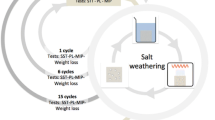Abstract
A customary procedure in the protection of monumental buildings is the consolidation of decaying stone by the application of commercial products containing tetraethoxysilane (TEOS). These products polymerize within the porous structure of the decaying stone, significantly increasing the cohesion of the material. However, TEOS-based consolidants suffer practical drawbacks, such as cracking of the network during the drying phase, and significant blocking of the rock pores. These limitations are related to the growth of a dense microporous network of the xerogel inside the stone material, which is typical from TEOS sols. Therefore, the purpose of this work is to increase porosity of the product by including colloidal particles in the starting sol.
We prepared a colloid-polymer composite gel using TEOS and a commercial silica colloid. The percentage by weight of silica colloid particles to total silica was 54%. Ethanol and dibutyltindilaurate (DBLT) were chosen as solvent and catalyst, respectively. This catalyst promotes the gelation at a neutral pH, preventing stone decay related to acid or basic catalysis. We characterized the properties playing a key role in consolidation. Data were compared with those obtained using a popular commercial product: Tegovakon V 100 produced by Goldsmith.
In spite of the colloidal particle addition, sols exhibited viscosity values close to those of the commercial products, as a consequence of their dispersion in ethanol. A gelation time similar to that of commercial consolidants was maintained, whereas the contained sol was stable over a period of up to six months. Concerning textural parameters, the addition of colloid permitted to obtain a crack-free, mesoporous material structure. This generated a crack-free material whereas the gel from Tegovakon V 100 exhibited cracking.
We also evaluated the consolidant efficacy on a biocalcareous stone, one of the most common monumental building stone employed in the southwest of Spain. Three key parameters -penetration depth in the rock, mechanical properties and water vapour diffusivity- were measured. Stone permeation was similar to that from the commercial product. Notably, a significant improvement of compression strength of the stone was observed. Reduction in vapour diffusivity of the treated stone was slightly lower for our gel than for the commercial consolidant.
Similar content being viewed by others
References
G.E. Wheeler, S.A. Fleming and S. Ebersole, Comparative Strengthening Effects of Several Consolidants on Wallace Sandstone and Indian Limestone, edited by J. Delgado, F. Henriques, and F. Jeremias (7th International Congress on Deterioration and Conservation of Stone, Proc. Vol. 3, Lisbon, Portugal, 1992) pp. 1033–1041.
G.W. Scherer and G.E. Wheeler, Stress Development Drying of Conservare OHR, edited by A. Moropoulou, F. Zezza, E. Kollias and I. Papachristodoulou (4th International Symposium on the Conservation of Monuments in the Mediterranean Proc. Vol. 3, Rhodes, Greece, 1997) pp. 355–362
M. J. Mosquera, J. Pozo, B. Silva, T. Rivas and E. Esquivias, J. Non-Cryst. Solids 311, 185 (2002).
M. J. Mosquera, J. Pozo and E. Esquivias, J. Sol-Gel Sci. Tech. 26, 1227 (2003).
M. R. Escalante, R.J. Flatt, G.W. Scherer, D. Tsiourva and A. Moropoulou, in Protection and Conservation of the Cultural Heritage of the Mediterranean Cities, edited by E. Galán and F. Zezza (A.A. Balkema, The Netherlands, 2002) pp. 425–429.
M.R. Escalante, J. Valenza and G.W. Scherer, in Proc. 9th International Congress on Deterioration and Conservation of Stone, Vol. 2, edited by V. Fassina (Elsevier, Venice, Italy, 2000) pp. 459–465.
M. J. Mosquera, M. Bejarano, N. de la Rosa-Fox and L. Esquivias, Langmuir, 19, 951 (2003).
L. Esquivias, N. de la Rosa-Fox, M. Bejarano and M.J. Mosquera, Langmuir, 20, 3416 (2004).
M.J. Mosquera and M. Bejarano, in Proc. 6th International Symposium on the Conservation of Monuments in the Mediterranean Basin, edited by L. Aires-Barros and F. Zezza (DGT Design, Lisbon, Portugal, 2004) pp. 467–471.
M.J. Mosquera, D. Benítez and S.H. Perry, Cem. Concr. Res., 32, 1883 (2002).
Acknowledgments
The authors are grateful for financial support from Spanish Government: Ministerio de Ciencia y Tecnología (Projects: MAT2001-3805 and MAT2003-0859). The authors are also grateful to Degussa Iberia, S.A. for supplying Aerosil OX-50 and to Goldschmidt España SA-Degussa for supplying Tegovakon-V100.
Author information
Authors and Affiliations
Rights and permissions
About this article
Cite this article
Mosquera, M.J., de los Santos, D. & Montes, A. Producing New Stone Consolidants for the Conservation of Monumental Stones. MRS Online Proceedings Library 852, 161–167 (2004). https://doi.org/10.1557/PROC-852-OO6.4
Published:
Issue Date:
DOI: https://doi.org/10.1557/PROC-852-OO6.4




